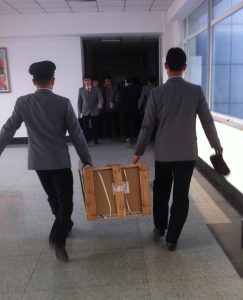This week, a fluorescence spectrophotometer arrived at the Pyongyang University of Science and Technology (PUST) campus and will soon be used by the students in the Agriculture and Life Sciences (ALS) school.

This new laboratory equipment, along with all other laboratory materials and equipment are donated by foreign faculty and staff and foreign supporters.
The fluorescence spectrophotometer will allow students to push their current boundaries of research and study. According to the Assistant Dean of the ALS School,
“The most common way to do spectroscopy is to shine light through a sample and
see how much light is absorbed by it. One wavelength after another is used and
a spectrum is mapped out showing absorption for each wavelength. The
spectrum can sometimes be used like a fingerprint to identify unknown samples,
or using a wavelength where absorbance is strong can tell how much of
something is in a sample. So it is often possible to can get qualitative and/or
quantitative information by shining light through the sample.
The difference with fluorescence is that light shining through the sample is not
what you measure. Instead the light causes something to happen in the sample,
and you measure that. Light is absorbed by exciting something in the sample.
When that excitation relaxes back to a stable state, light is given back off. The
light given off is what is measured. It is not usually at the same wavelength as
what was put in. The difference can be informative.
One big thing about the different approach is sensitivity. We look for a small
signal, but it appears against a dark background. The absorbance method looks
for a decrease in a strong signal. It is like starting with everyone in an auditorium
holding a lit candle, and trying to measure the decrease if a few people blow
theirs out. This method is more like a dark room where somebody lights a
candle. It is easier to see that difference.
Another thing that is handy about this method is that it is easy to do by shining
light on a solid surface. If we have a spot on a piece of paper, we can put it in the
beam and see what light comes from it. That could be helpful for us.”
